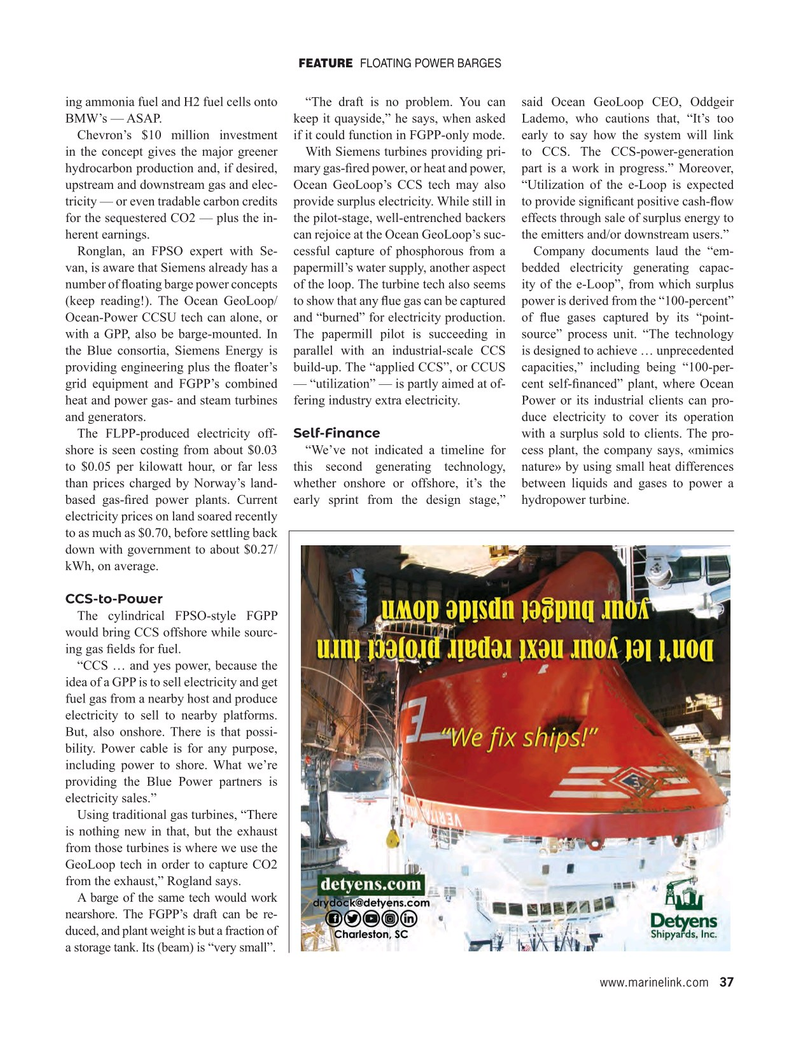
Page 37: of Maritime Reporter Magazine (November 2022)
The Workboat Edition
Read this page in Pdf, Flash or Html5 edition of November 2022 Maritime Reporter Magazine
FEATURE FLOATING POWER BARGES ing ammonia fuel and H2 fuel cells onto “The draft is no problem. You can said Ocean GeoLoop CEO, Oddgeir
BMW’s — ASAP. keep it quayside,” he says, when asked Lademo, who cautions that, “It’s too
Chevron’s $10 million investment if it could function in FGPP-only mode. early to say how the system will link in the concept gives the major greener With Siemens turbines providing pri- to CCS. The CCS-power-generation hydrocarbon production and, if desired, mary gas-? red power, or heat and power, part is a work in progress.” Moreover, upstream and downstream gas and elec- Ocean GeoLoop’s CCS tech may also “Utilization of the e-Loop is expected tricity — or even tradable carbon credits provide surplus electricity. While still in to provide signi? cant positive cash-? ow for the sequestered CO2 — plus the in- the pilot-stage, well-entrenched backers effects through sale of surplus energy to herent earnings. can rejoice at the Ocean GeoLoop’s suc- the emitters and/or downstream users.”
Ronglan, an FPSO expert with Se- cessful capture of phosphorous from a Company documents laud the “em- van, is aware that Siemens already has a papermill’s water supply, another aspect bedded electricity generating capac- number of ? oating barge power concepts of the loop. The turbine tech also seems ity of the e-Loop”, from which surplus (keep reading!). The Ocean GeoLoop/ to show that any ? ue gas can be captured power is derived from the “100-percent”
Ocean-Power CCSU tech can alone, or and “burned” for electricity production. of ? ue gases captured by its “point- with a GPP, also be barge-mounted. In The papermill pilot is succeeding in source” process unit. “The technology the Blue consortia, Siemens Energy is parallel with an industrial-scale CCS is designed to achieve … unprecedented providing engineering plus the ? oater’s build-up. The “applied CCS”, or CCUS capacities,” including being “100-per- grid equipment and FGPP’s combined — “utilization” — is partly aimed at of- cent self-? nanced” plant, where Ocean heat and power gas- and steam turbines fering industry extra electricity. Power or its industrial clients can pro- and generators. duce electricity to cover its operation
The FLPP-produced electricity off- Self-Finance with a surplus sold to clients. The pro- shore is seen costing from about $0.03 “We’ve not indicated a timeline for cess plant, the company says, «mimics to $0.05 per kilowatt hour, or far less this second generating technology, nature» by using small heat differences than prices charged by Norway’s land- whether onshore or offshore, it’s the between liquids and gases to power a based gas-? red power plants. Current early sprint from the design stage,” hydropower turbine. electricity prices on land soared recently to as much as $0.70, before settling back down with government to about $0.27/ kWh, on average.
CCS-to-Power
The cylindrical FPSO-style FGPP would bring CCS offshore while sourc- ing gas ? elds for fuel. “CCS … and yes power, because the idea of a GPP is to sell electricity and get fuel gas from a nearby host and produce electricity to sell to nearby platforms.
But, also onshore. There is that possi- bility. Power cable is for any purpose, including power to shore. What we’re providing the Blue Power partners is electricity sales.”
Using traditional gas turbines, “There is nothing new in that, but the exhaust from those turbines is where we use the
GeoLoop tech in order to capture CO2 from the exhaust,” Rogland says.
A barge of the same tech would work nearshore. The FGPP’s draft can be re- duced, and plant weight is but a fraction of a storage tank. Its (beam) is “very small”. www.marinelink.com 37
MR #11 (34-49).indd 37 11/4/2022 1:26:53 PM

 36
36

 38
38
